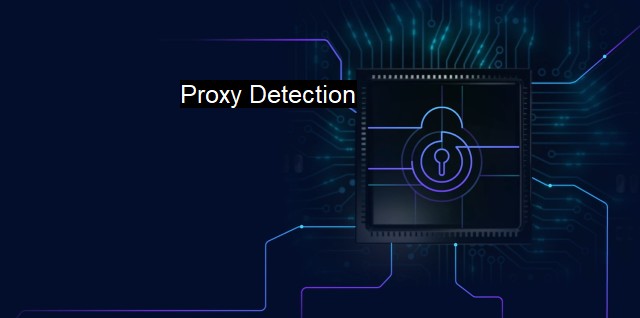What is Proxy Detection?
Proxy Detection: A Crucial Tool for Strengthening Cybersecurity and Antivirus Measures
Proxy detection is an essential tool in the realm of cybersecurity and antivirus solutions. It pertains to the process of recognizing and identifying proxy servers being used by web users to conceal their actual identity or location. As such, proxy detection can be a necessary element for various cybersecurity tasks, like enforcing content access policies based on geography or thwarting malicious activities that exploit the anonymity offered by proxy servers.A proxy server fundamentally acts as a gateway between the user and the internet. It provides a separate level of abstraction and control, which can be used to increase privacy and perform specific network operations efficiently. For instance, a user located geographically outside the official broadcast area of a streaming service can use a proxy server to bypass this limitation, permitting them access which they might not otherwise have.
Proxy servers can also be used for malicious purposes, such as hiding the origins of an attack, logging keystrokes, promoting identity theft, or distributing control software for botnets. These involved risks render them a significant concern for cybersecurity professionals, necessitating the need for effective proxy detection systems.
Verification methods of proxy detection generally employ numerous techniques. A prevalent way used by websites is to check for IP addresses known to be associated with popular commercial VPNs or proxy services, as they operate from a specific range of IP addresses. Proxies can further forward data regarding the use of a proxy in HTTP headers, indicating their presence. More advanced detection systems authorize a direct communication link to the suspected proxy, studying the response and timing details to authorize an incoming connection.
In the antivirus context, proxy detection evolves as a potent shield against potential malware attacks. Malefactors frequently utilize proxies in injecting malware into systems silently. This practice allows infiltrators to access the system unnoticed, extract data, or impair the system's functionality. Techniques involving proxy server tracking thereby enhance the efficacy of antivirus applications.
For businesses handling sensitive information and transactions, proxy detection arises as an invaluable resource. It empowers organizations with an additional security layer: determining the actual identity of the user hidden behind the proxy server. By tracking VPNs and proxies, businesses can gain better control of their network, prevent unauthorized access to sensitive data, and reduce the risk of potentially damaging cyber-attacks.
While it may seem that only negative attributes are associated with proxy servers, they do serve a critical role concerning online privacy in this increasingly interconnected digital world. The privacy and protection they offer are particularly beneficial to whistleblowers or individuals in nations where internet usage is heavily monitored.
It's also valid that such servers can be and often are, manipulated with harmful intentions. It propels the requirement for robust proxy detection mechanisms for protecting businesses and individuals alike from cyber threats. Cybersecurity professionals must continuously explore novel proxy detection techniques and improve their strategies, considering the evolving nature of malware attacks and the ingenious ways implemented by cyber-criminals to exploit the proxy servers.
While proxy detection does not completely immunize a system from cyber-attacks or malware, it significantly heightens the defenses against attackers logging in through a proxy. Thus, ensuring secure environments using effective proxy detection techniques proves crucial from antivirus and cybersecurity standpoints. Therefore, proxy identities, far from being a trivial matter, are of vital importance for businesses and individuals alike when guarding against potent cybersecurity threats. Implementing robust proxy detection is a significant step toward ensuring the digital world is safer and more secure.

Proxy Detection FAQs
Why is proxy detection important for cybersecurity?
Proxy detection is important for cybersecurity because it helps identify and block malicious traffic or attacks that may be originating from a proxy server. Hackers often use proxy servers to hide their location and evade detection, making it more challenging for cybersecurity professionals to track and prevent these attacks.How does proxy detection work in antivirus software?
Antivirus software uses a variety of methods to detect proxies, including checking IP addresses for known proxy servers, analyzing traffic patterns, and scanning for specific proxy-related keywords. Some antivirus software can even detect and block encrypted proxy traffic, providing an extra layer of protection against advanced threats.What are the benefits of proxy detection for businesses?
Proxy detection can help businesses protect their networks and data from cyber threats, which can result in financial loss, reputation damage, and legal liabilities. By identifying and blocking malicious traffic, businesses can prevent cyber attacks, data breaches, and other security incidents that can disrupt operations and cause significant harm.Is proxy detection enough to ensure complete cybersecurity?
Proxy detection is an important tool for cybersecurity, but it is not enough on its own. To ensure complete cybersecurity, businesses need to implement a comprehensive security strategy that includes multiple layers of protection, such as firewalls, antivirus software, intrusion detection and prevention systems, and employee training programs. Combining these tools with proxy detection can help businesses stay ahead of evolving cyber threats and minimize their risks.| | A | | | B | | | C | | | D | | | E | | | F | | | G | | | H | | | I | | | J | | | K | | | L | | | M | |
| | N | | | O | | | P | | | Q | | | R | | | S | | | T | | | U | | | V | | | W | | | X | | | Y | | | Z | |
| | 1 | | | 2 | | | 3 | | | 4 | | | 7 | | | 8 | | |||||||